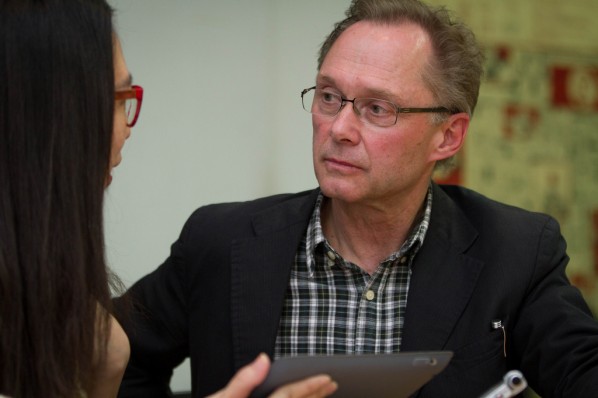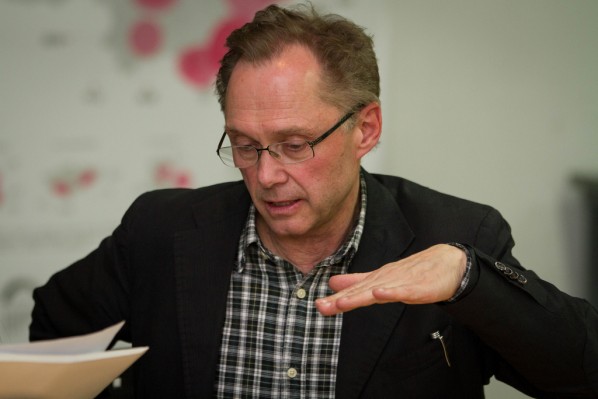
In an exclusive interview, CAFA ART INFO met Mr. Bernhard Serexhe, Chief Curator of ZKM | Karlsruhe, after he gave a lecture on ZKM | Karlsruhe at CAFA Media Lab.
As a cultural institution, the Center for Art and Media (ZKM) in Karlsruhe holds a unique position in the world. It responds to the rapid developments in information technology and today’s changing social structures. Its work combines production and research, exhibitions and events, coordination and documentation. For the development of interdisciplinary projects and promotion of international collaborations, the Center for Art and Media has manifold resources at its disposal: the Museum of Contemporary Art, the Media Museum, the Institute for Visual Media, theInstitute for Music and Acoustics and the Institute for Media, Education, and Economics.
Bernhard Serexhe, born in 1950, studies in sociology, psychology, art history, philosophy, educational science, doctorate in art history on the cathedral of Autun (France), archaeological research and restauration studies on romanesque architecture in Burgundy, scientific publications on architecture and heritage history, art and media theory. Since 1995 consultant for the Council of Europe, NGOs and other cultural institutions. 1994-1997 curator of the Media Museum of the ZKM | Centre for Art and Media Karlsruhe, 1998-2005 head of the ZKM | Museum Communication, since 2006 Chief Curator ZKM | Media Museum. Lectureships: 1999 Russian Akademie of Fine Arts St Petersburg, 2000-2001 and 2008 University of Berne, 2001 University of Basel, 2001 University of the Arts Karlsruhe, 2002-2006 lectureship for media art at the University of Karlsruhe. Since 2008 Professor for Aesthetics and Media Theory at the Istanbul BILGIUniversity. Since 2010 initiator and leader of the EU-funded research project digital art conservation.
As far as we know that you work as the chief curator of Center for Art and Media Karlsruhe (Germany), and you cooperated with two curators on a recent exhibition “Move on Asia” on view at ZKM. (The selection of works that make up “Move on Asia” draws on the large-scale festival of moving digital pictures in Asia of the same name organized by a network of 20 curators and 40 video artists since 2004.) Would you briefly introduce your future program in ZKM?
Bernhard Serexhe: Right ahead? It’s really so much. One of my programs is to continue the research on the preservation of digital art. So there’s another exhibition which I will do this year and it’s an exhibition on a very important American artist and poet, his name is Allen Ginsberg. So we have produced digitalized quite a lot of material of Allen Ginsberg, of his performances, and interviews, films, photographs, audio recordings. And this could be one of the exhibitions which could travel from Germany to Beijing for instance because the material is all digital, and what we would need to do this exhibition at CAFA Art Museum for instance, this would be just projectors, loud speakers and headphones, and some computers, that’s it. It will be very easy to do this exhibition. This is one of the exhibitions, the other exhibition I will do in the summer is on Holography because we have a important collection of holographic images. And this collection has to be shown. The third exhibition I will be doing together with my colleague Stephan Schwingeler is the new ZKM_gameplay. This exhibition is concerning computer games, also here, I would like to include CAFA Media Lab with Fei Jun, for instance. We are also working with Feng Mengbo. I have seen his exhibition at Chambers Gallery in October here in Beijing. So these is a little part of what we are doing this year but there will be even much more.
I heard you’ve been to Korea before you came to Beijing. What do you think of the difference of contemporary art between China and Korea?
Bernhard Serexhe: No difference. Today I’m nearly no longer talking about German art, or Italian art, or Korean art, or Chinese art. We are talking about global art, isn’t it? The contemporary art in Korea is not very much different from the contemporary art in China. Why should these be different? There are different languages, and different traditions, and what I feel is that Chinese contemporary art is still very much connected to the very high-level cultural traditions of China. And this is something I like very much. And this is one of the reasons why I come to CAFA.
Then what do you think of the development of new media art in China?
Bernhard Serexhe: I think it’s very much advanced. I think it’s developping very fast and I have tried to get a kind of overview since about one year. I’v been three times in Beijing and have connected to many artists. So I would say in China the contemporary art is at least as much as advanced than in any other country. Here I don’t see any difference in advancement, so all the Chinese artists I have met are very, very serious about what they are doing.
We know that this is not your first trip to China and you have cooperated with UCCA in Beijing. Would you be looking forward to some future co-operations with museums or art galleries in Beijing or across the country?
Bernhard Serexhe: We are. So I have opened three days ago one ZKM exhibition in Beijing in the new MOMA Space. This exhibition is on the AppArtAward of ZKM. So this is a kind of cooperation and I would like to cooperate much more with the exhibitions which are being done in China or in Germany, and to have much more exchange between the institutions. Why should one create a precious exhibition, for instance the Allen Ginsberg exhibition, only for one place or for one time. It’s a waste. It’s a waste of intelligence, a waste of energy, a waste of money… And we should share this kind of exhibition. So if I would very much appreciate if the CAFA museums curators would like to cooperate. I would be very much pleased to exchange this kind of exhibitions in the future, in the near future.

As far as we know, curator Susanne Gaenscheimer, who has selected fours artists represent Germany Pavilion at the 55th Venice Biennale. None of the four artists are German, one of which is Ai Weiwei. How do you think she chose Ai Weiwei?
Bernhard Serexhe: Well, I think in Germany contemporary art is no longer regarded as "German art", so for the Venice Beinnial one could choose any artist who is working on the connection with contemporary art in Germany. And Ai Weiwei for instance, is doing this. But I also think especially concerning the hype about Ai Weiwei in the art scene is being too much exaggerated. There is not only Ai Weiwei as a Chinese artist, there are so many other artists in China. But wherever you go in the world today and say the two words “Chinese" and "Art” you will have the automatic reply: “Oh, Ai Weiwei, Ai Weiwei, Ai Weiwei!” And this would be a little sad that the other Chinese artists which are also very important, which are even better sometimes are not named, not talked and there’s always “Ai Weiwei”. This is disturbing a lot of people.
Could you name some of the most important Chinese contemporary artists in China?
Bernhard Serexhe: This is a too much difficult question. Some of which I like very much, Song Dong for instance, Yin Xiuzhen, Yang Fudong, and many of them, also Miao Xiaochun …there are so many, many very good artists, Li Songsong for instance, is one of the most interesting artists. I’ve seen his exhibition in Pace Gallery last year. I also saw Li Songsong’s studio and his work. And another one could be Feng Mengbo. There are so many you know and it’s quite difficult to answer this kind of questions since you try to limit yourself to four or five names, but there are hundreds of very interesting contemporary artists in China today.
What do you think of the way of saying that the four artists chosen to feature their works at the German pavilion on the 55hth Venice Biennale represent not the Germans but the German spirit?
Bernhard Serexhe: I would say today Germany is a very, very open minded spirit. In this sense I understand why four artists have been selected for the German Pavilion of Venice Biennial.
Text by Sue Wang and photo by Hu Zhiheng/CAFA ART INFO




























